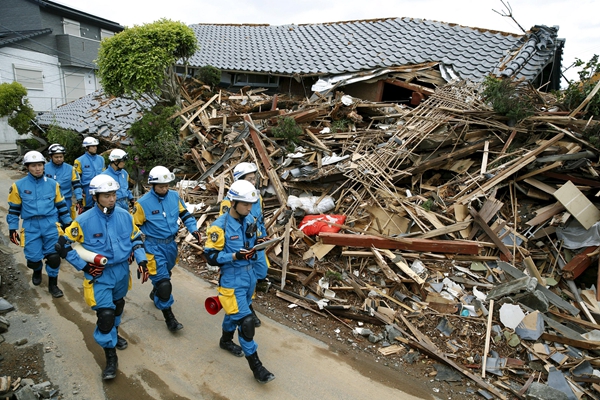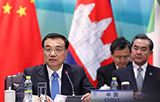Tourists moved out of quake-stricken area
By Cai Hong in Tokyo (China Daily) Updated: 2016-04-18 02:28
 |
|
Police officers check a collapsed house after an earthquake in Mashiki town, Kumamoto prefecture, southern Japan, in this photo taken by Kyodo April 17, 2016.[Photo/Agencies] |
A group of 20 Chinese tourists have been moved away from an earthquake-hit area of Japan, China's consulate-general in Fukuoka said on Sunday.
The tourists were moved on Saturday, with weekend quakes also reported in Ecuador in South America and the Pacific island nation of Tonga.
The consulate-general warned Chinese tourists not to visit the Kyushu area of Japan, where a quake jolted Kumamoto prefecture on Thursday night. Forty-one people were killed and 1,500 injured. There were no reports of Chinese casualties.
On Saturday morning, a magnitude-7.3 quake hit Kyushu's other prefectures of Oita, Fukuoka, Nagasaki, Miyazaki and Kagoshima.
In Ecuador, the Risk Management Agency said 10,000 armed forces personnel were deployed to help people in a coastal area stuck by a magnitude-7.8 quake. The country's vice-president put the death toll at 77, with 588 people injured.
A magnitude-6.1 quake hit Tonga on Sunday, the US Geological Survey said. It struck 277 kilometers southeast of the capital Nuku'alofa at a depth of 66 kilometers.
In Japan, rail services on the Kyushu Shinkansen line were suspended and road links cut.
The Chinese consulate-general in Fukuoka, which sent two teams to Kumamoto prefecture, said it was trying to help Chinese citizens, Chinese employees in the China-funded companies and travelers from the country.
The Chinese embassy in Tokyo on Saturday asked Chinese citizens in Japan to take measures to safeguard themselves from earthquakes and other disasters.
Japanese seismologists fear that a series of quakes jolting Kyushu could trigger tremors elsewhere on the southwestern island, according to the Japanese daily Asahi Shimbun.
The epicenter of Thursday's quake is gradually moving eastward, Ichiro Kawasaki, professor emeritus of seismology at Kyoto University, was quoted by the newspaper as saying.
He said that when a quake occurs, different pressure is exerted on other faults around it, which could trigger further quakes.
In an interview with the Mainichi Shimbun newspaper, Takashi Furumura, a professor of seismology at the University of Tokyo, said Thursday's quake occurred in an area with a complex structure of multiple fault lines running next to each other.
"There is a possibility of a larger aftershock than what we have seen so far, and vigilance is needed," Furumura said.
The Japanese government mobilized 25,000 members of the Self-Defense Forces for rescue operations in the disaster-stricken areas.
Cheng Yonghua, China's ambassador to Japan, sent a letter of sympathy to Kumamoto Governor Ikuo Kabashima on Friday, expressing his condolences to families of those who died.
- Damaged infrastructure hinders search, aid for Japan quake survivors
- Aerial shots show Japan prefecture devastated by earthquake
- Two strong quakes kill 41 in SW Japan, heavy rain predicted in quake-hit region
- China expresses sympathy to Japan over earthquakes
- Chinese nationals in Japan quake area 'safe'







